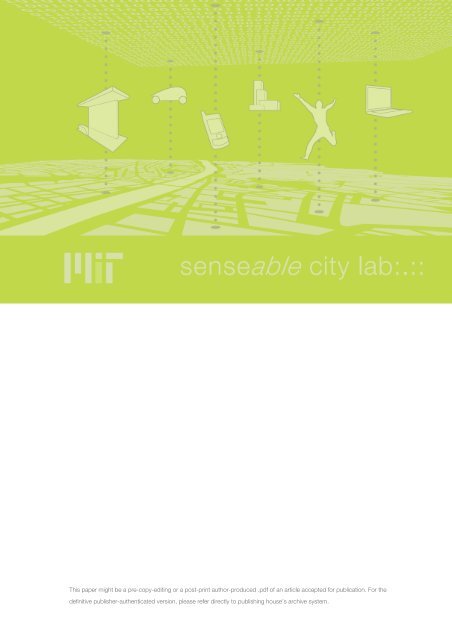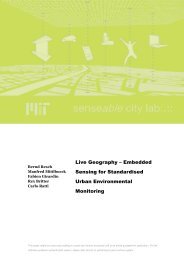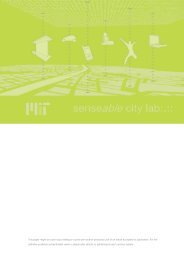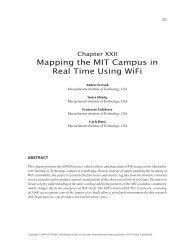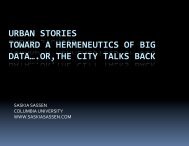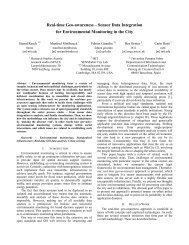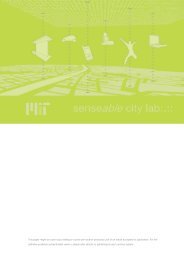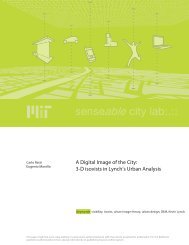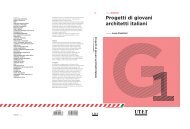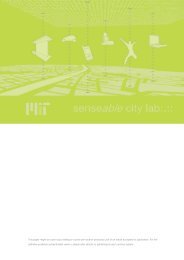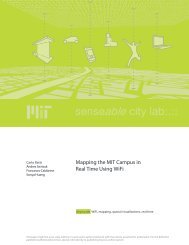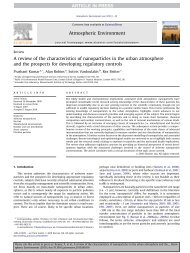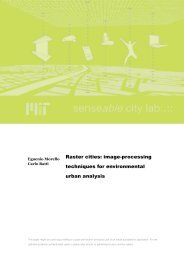Urban Digestive Systems. Towards the Sentient City. - MIT ...
Urban Digestive Systems. Towards the Sentient City. - MIT ...
Urban Digestive Systems. Towards the Sentient City. - MIT ...
- No tags were found...
Create successful ePaper yourself
Turn your PDF publications into a flip-book with our unique Google optimized e-Paper software.
for <strong>the</strong> 21st Century,” a ubiquitous logic deeplyembedded in everyday environments andactions (Weiser 1991). His vision liberatesinformation from <strong>the</strong> virtual space behind <strong>the</strong>screen. Instead, technology is seamlessly embeddedin every object, effortlessly integratedinto daily routines. Arranging smart objectson a table triggers meaningful computationalinteractions, just as command sequences doon a traditional computer. Using sensor data,phones automatically recognize social context,such as a meeting or film screening, and adjust<strong>the</strong>ir behavior accordingly.This idea extends to scenarios where everyobject can sense relevant information about itsenvironment, infer <strong>the</strong> situation, and spontaneouslycommunicate with nearby devices orbroadcast its state to <strong>the</strong> world. Julian Bleeckerdubbed <strong>the</strong>se blogging objects, or ‘blogjects’(Bleecker 2005). Alternatively, as sensingdevices miniaturize and distribute pervasively,<strong>the</strong>y become smart dust, an invisible, intelligentinfrastructure for real-time environmentalsensing. Through such transformative technologies,<strong>the</strong> <strong>Sentient</strong> <strong>City</strong> can meet our growingdemand for rich, accurate, timely information.Smart dust, in particular, was a usefulstarting point for investigating <strong>the</strong> movementof garbage. We scattered our location sensorsinto <strong>the</strong> removal chain like dust particles in <strong>the</strong>wind, with no hope of retrieving <strong>the</strong>m afterwards.The sensors journeyed within heaps oftrash, detected <strong>the</strong>ir own locations, reportedback to our servers, and allowed us to observe<strong>the</strong> unseen infrastructure <strong>the</strong>y inhabited.Eventually, <strong>the</strong>ir batteries depleted and <strong>the</strong>ircircuits were damaged from wear and tear, <strong>the</strong>ystopped speaking and became indistinguishablefrom <strong>the</strong> surrounding trash.***In 2008, journalists from Greenpeace investigatedrumors of electronic waste exporting,a legal practice in <strong>the</strong> United States, butoutlawed in most countries of <strong>the</strong> world as aresult of <strong>the</strong> International Treaty of <strong>the</strong> BaselConvention. The journalists embedded GPSsensors into television sets that were brokenbeyond repair, and brought <strong>the</strong>m to a localrecycling facility in <strong>the</strong> UK. Despite legislationbanning <strong>the</strong> movement of e-waste betweennations, <strong>the</strong> defunct televisions were trackedall <strong>the</strong> way to Nigeria, where <strong>the</strong>y were likelyillegally dumped.Waste removal is a complex process,subject to myriad regulations and multipleexchanges that are difficult to track. Potentialfor fraud has always existed in this tangledweb, driving a long history of organized crimecontrol over <strong>the</strong> industry in various parts of<strong>the</strong> world. Most often this disproportionatelyaffects poorer areas over wealthier ones, raisingquestions of environmental justice when<strong>the</strong> consequences threaten public health.Globalization has made <strong>the</strong>se transboundaryissues, as people attempt to cheaply exporthazardous waste to countries with lax regulations,instead of complying with local standards.Paradoxically, <strong>the</strong> very regulations thatshould prevent misuse have generated a greymarket for waste, where profit can be madeby bypassing legal procedures.The sheer volume of garbage that wegenerate also threatens sustainability. Goodsconsumption and garbage production are constantlyrising, yet safe and affordable landfillspace is becoming harder to find. In addition,most small regional landfills at <strong>the</strong> urbanfringe have been shut down, as cities have expandedand pushed out <strong>the</strong>se practices. As aresult, waste travels much fur<strong>the</strong>r than before,using more energy and producing more emissions.Fur<strong>the</strong>rmore, closed landfill sites oftencarry toxic legacies that require remediationand constrain later land use; thus hazardouswaste disposal becomes especially costly andvulnerable to fraudulent practices.***To ensure responsible waste removal, <strong>the</strong>proximity principle, as outlined in <strong>the</strong> BaselConvention, demands that waste is disposedof as close as possible to its source (Kummer,1999). However, waste removal chains areoften inadequately monitored to ensureenforcement. Such chains can involve manydifferent companies, but very little informationis passed between <strong>the</strong>m; a standardizedinformation model for tracking waste doesnot exist. As a result, current procedures formonitoring <strong>the</strong> process rely on paper protocolsand voluntary evaluations of facilities, asystem built almost entirely on trust.As <strong>the</strong> “following <strong>the</strong> e-waste trail” projectby Greenpeace shows, technology can overcomemany of <strong>the</strong>se obstacles (GreenpeaceInternational 2008). Active GPS-based locationsensors can effectively monitor individualwaste items anywhere in <strong>the</strong> world,highlighting potential abuse. Because sensorsare irretrievable once thrown away, GSM(Global Standard for Mobile Communications)and o<strong>the</strong>r mobile phone networks are importantinfrastructures for real-time communication.Online databases collect and storethis data remotely; advanced analytical andmapping software allow us to make sense ofmassive amounts of location data and pickout patterns from <strong>the</strong> noise.There are also low-tech methods of tracking<strong>the</strong> motion of refuse, like relying on manyvolunteers to act as temporary sensors. A famousnaval spill of 29,000 rubber toys in 1992enabled a long-term study of ocean currentsin <strong>the</strong> Pacific. Oceanographers Ebbesmeyerand Ingraham recruited local residents,visitors, and beach workers to recover toysbeing washed ashore in Alaska. Based on <strong>the</strong>locations of around 400 found toys, scientistsrefined <strong>the</strong>ir models of oceanic currents andcorrectly predicted <strong>the</strong> trajectories of <strong>the</strong>remaining toys (Ebbesmeyer et al. 2007). Thisdemonstrates what can be achieved by engaginga community even without expensivetracking technology.Beyond <strong>the</strong> tracking process itself, <strong>the</strong>re areimportant precedents for communicating ourobservations to <strong>the</strong> public. One relevant priorwork is Eric Paulos’ Jetsam project (Paulos andJenkins 2005), which sought to improve publicawareness of waste issues. They deployed atrash bin in public space that was equippedwith various sensors and network connectivity.This ‘augmented trash bin’ gave feedback toits users by displaying statistical informationabout collected waste via projected visualizations.Such real-time feedback can deliverinformation about waste disposal in an intelligible,resonant way, and could potentially drivegreater awareness and behavioral change.These examples are at <strong>the</strong> core of whatwe are after. Yet, Trash Track goes beyondall of <strong>the</strong> above approaches, using pervasivetechnologies and volunteer mobilization toexpose challenges of waste management andsustainability to <strong>the</strong> world. It builds on previouswork by <strong>the</strong> SENSEable <strong>City</strong> Lab thatexplores how <strong>the</strong> increasing deployment ofsensors and mobile technologies radicallytransforms our understanding and descriptionof cities. The project is an initial investigationinto understanding <strong>the</strong> removal chain in urbanareas, and represents a model for change thatis taking hold in cities: a bottom-up approachto managing resources and promoting environmentalawareness. Trash Track hints at animportant, but little discussed aspect of <strong>the</strong>vision described as <strong>the</strong> Internet of Things. Asargued by <strong>the</strong> novelist Bruce Sterling, we candirect every object to <strong>the</strong> optimal reuse scenarioand ultimately achieve a condition withzero waste, if we know where all things are in<strong>the</strong> world (Sterling 2005).Technology DesignThe whole project has made me much moreoptimistic about our ability to find solutions tobig, complex problems. Seeing how <strong>the</strong> peopleinvolved in <strong>the</strong> project are using <strong>the</strong>ir creativityand scientific expertise to tackle something asmundane yet complicated as trash disposal isvery encouraging.— Trash Track volunteer survey***The Trash Track project was conceived in <strong>the</strong>summer of 2008 as a proposal for <strong>the</strong> Toward<strong>the</strong> <strong>Sentient</strong> <strong>City</strong> exhibition, organized by <strong>the</strong>Architectural League of New York. Rex Britter, avisiting scientist with <strong>the</strong> SENSEable <strong>City</strong> Lab,suggested <strong>the</strong> idea of tracking garbage in <strong>the</strong>city in order to better understand <strong>the</strong> collectionof waste — which Bill Mitchell dubbed <strong>the</strong> ‘removalchain’ as <strong>the</strong> counterpart to <strong>the</strong> supplychain — and eventually improve its logistics.Tracking trash intrigued us both as a windowinto its environmental impact on <strong>the</strong> city and asan extension to <strong>the</strong> Lab’s past work in diffusepervasive digital sensing to explore <strong>the</strong> physicalcontext of <strong>the</strong> city.The Trash Track concept also raised questionsand concerns in its developmental phase.Was <strong>the</strong> inevitable deposit of potentially toxictracking electronics into landfills contrary to <strong>the</strong>environmental goal of <strong>the</strong> project? Any demonstrationof this technology would inevitablyproduce a small amount of electronic waste,but <strong>the</strong> knowledge and information obtained bytracking waste products could provide enormousbenefits outweighing <strong>the</strong> risks. Thinkingahead to <strong>the</strong> future, it will be possible to carryout projects like Trash Track in more environmentallyfriendly ways. Rapid miniaturization,organically based batteries, and self-poweringmethods will all contribute to <strong>the</strong> greening ofelectronic sensing devices.94-95 <strong>MIT</strong> Senseable <strong>City</strong> Lab Trash Track
Evaluating different materials for protecting <strong>the</strong> sensors from <strong>the</strong> physical impacts inside <strong>the</strong> waste stream.***While our initial concept of tracking trash wasrelatively simple, a number of constraintscomplicated development and implementation.Due to <strong>the</strong> wide variety of waste items, materials,and treatment processes, we needed alarge number of tags to track a representativesample; distributing ten or twenty tags wouldyield only anecdotal results. It was also impracticalto try to recover and reuse tags once<strong>the</strong>y entered <strong>the</strong> waste stream. For both of<strong>the</strong>se reasons, it was crucial that <strong>the</strong> tags wereobtainable at very low cost.The range and variety of trash paths made<strong>the</strong>m impossible to predict a priori, so it wascritical that <strong>the</strong> tags were able to self-locateand transmit <strong>the</strong>ir location information fromanywhere in <strong>the</strong> country. Finally, due to <strong>the</strong> potentiallylong travel time of trash, our sensorsrequired long-lasting battery performance thatwas not easily met by off-<strong>the</strong>-shelf commercialsolutions. Most available devices have to berecharged every few days; when potentiallyfollowing garbage for months, this was notfeasible.Given <strong>the</strong> costs of active sensors, passiveRFID (radio-frequency identification) tagsseemed like an attractive alternative. RFID wasalready commonly used to track items in retailsupply chains; <strong>the</strong> low price of <strong>the</strong>se tags made<strong>the</strong>m cost-effective to deploy in large numbers.However, as a near-field localization technology,RFID would have required an additionalnetwork of tag reading devices, deployed at everypotential stop and destination in <strong>the</strong> wastestream. Besides <strong>the</strong> prohibitive cost of buildingthis network from scratch, an RFID solutionwould also be unable to track <strong>the</strong> most interestingcases of trash, those that went astray fromexpected paths.Therefore, active-reporting infrastructurewas critical to tracking object movement in anunconstrained system like <strong>the</strong> waste removalchain. We chose a tracking technology basedon <strong>the</strong> GSM cell phone network, since it notonly provided a solution for location sensing,but also offered a communications channel forreporting <strong>the</strong> sensed locations back to us. Byidentifying cell towers in <strong>the</strong> proximity to <strong>the</strong>device and triangulating <strong>the</strong>ir known coordinates,GSM could provide coarse-grainedlocation sensing. In addition, <strong>the</strong> GSM networkallowed sensors to actively communicate backthrough those cell towers.***Two generations of Trash Tags were developedat <strong>MIT</strong> by utilizing an off-<strong>the</strong>-shelf GSMdata modem chipset, microcontroller, motionsensor, and a custom printed circuit boardDifferent waste items waiting to be tagged, contributed by Eatonville High School students.with an integrated trace antenna. After gainingdeployment experience with <strong>the</strong> first generationtags, a new design was developed prior to<strong>the</strong> second production run. This developmentprocess focused on simplifying tag designin order to (1) reduce power requirements toreduce battery size, (2) shrink form size usinga low-cost, small antenna design, (3) consumefewer electronics and improve environmentalperformance, and (4) minimize packagingwithout sacrificing <strong>the</strong> robustness needed tosurvive impacts in <strong>the</strong> removal chain.To minimize power consumption, <strong>the</strong> tagswere equipped with an algorithm that wouldawaken <strong>the</strong> tag upon detection of motion by <strong>the</strong>motion sensor. Tags would scan all channelsand bands for cell towers; locate <strong>the</strong> strongesttwelve cell sites nearby and store <strong>the</strong>ir identificationinformation. Subsequently, <strong>the</strong> tagscompressed tower reports into Short MessageService (SMS) messages and periodically sent<strong>the</strong>m to a server; low frequency of communicationwas critical to maximizing battery life. Interms of environmental performance, <strong>the</strong> secondgeneration of tags was lead-free and usedcomponents containing very little or negligiblehazardous substances. As a result, <strong>the</strong> GSMtags complied with environmental standardssuch as <strong>the</strong> European Union’s Restriction ofHazardous Substances Directive, designed toreduce <strong>the</strong> disposal of hazardous substances inelectronic equipment.The final deployment used tracking devicesdeveloped separately by Qualcomm. Thesetook advantage of GPRS and GPS technologyto deliver more accurate location reports. TheQualcomm tags were similar in size to previousgenerations, and had a sleep mode for conservingenergy, a crucial feature for our experiment.Ra<strong>the</strong>r than activating on motion, <strong>the</strong> sensorswere configured to report <strong>the</strong>ir location everythree to six hours; we chose several differentreporting cycles to balance between <strong>the</strong> needfor longer battery life and for more detailedtraces in space and time.Evaluating tag performance in <strong>the</strong> fieldrevealed three important limitations: batterylife, failure rates and accuracy of <strong>the</strong> locationreports:— It was difficult to clearly define expectedbattery lifetime because of <strong>the</strong> varied nature of<strong>the</strong> conditions experienced by individual tags.Since <strong>the</strong> sleep mode is very low power relativeto when <strong>the</strong> cellular module is active, <strong>the</strong>lifetime was strongly affected by <strong>the</strong> amountof time that <strong>the</strong> tag was actually in motion, andby <strong>the</strong> algorithm for turning on <strong>the</strong> system inresponse to vibration. Based on our data, weestimated that our tags had sufficient energy96–97 <strong>MIT</strong> Senseable <strong>City</strong> Lab Trash Track
to operate for 20-30 hours when constantly inmotion, and from 3-6 months in sleep mode.— We noticed that about 20% of <strong>the</strong> tags ei<strong>the</strong>rreported very short traces or failed to senda report at all. Tags could have failed for anynumber of reasons: destruction during <strong>the</strong>waste removal process, arriving somewhere<strong>the</strong> transmission signal was blocked, hardwaremalfunctions of <strong>the</strong> tracking device, or humanerrors resulting from volunteers not disposingof <strong>the</strong> tagged item. We found that failure ratesdepended heavily on <strong>the</strong> packaging strategyand type of trash; battery failure turned out tobe less of a problem than physical destruction.— The location reports we received had limitedresolution in time, due to <strong>the</strong> power-conservingmeasures explained earlier. However, <strong>the</strong>resolution was sufficiently high for inferencesabout <strong>the</strong> route and <strong>the</strong> mode of transportation.The accuracy for GSM based localization canbe estimated at about 250 m. GPS localizationsignificantly improved this accuracy. However,since <strong>the</strong> GPS signal required a clear view of<strong>the</strong> sky, this feature was not always available.DeploymentsThe blend of technology, information systems,and my own lack of concrete knowledge aboutwhere trash goes were <strong>the</strong> primary catalysts.A strong feeling that I wanted to influenceo<strong>the</strong>rs in <strong>the</strong> Seattle area to get involved at <strong>the</strong>local level was a secondary — but still important— motivation.— Trash Track volunteer survey***Over several phases of <strong>the</strong> Trash Track project,we distributed a total of 3,000 sensors in<strong>the</strong> cities of Seattle, New York, and London.The initial field test of trash tags took placein June 2009 in Seattle, Washington. Our primarygoal was to test <strong>the</strong> tags’ performanceonce <strong>the</strong>y had entered <strong>the</strong> waste removalstream. We also wanted to sample data from awide distribution of disposal locations across<strong>the</strong> city. Driving to <strong>the</strong>se target locations, wefound many objects simply lying around onstreets and empty lots. Examples includedbeverage containers and newspapers, toysand batteries, cell phones and computers, applianceslarge and small, furniture and clothing,and hazardous materials and car parts.We tagged each of <strong>the</strong>se found items, tryingout different techniques for attaching <strong>the</strong>msecurely. Tagged objects were <strong>the</strong>n droppedinto public garbage bins, brought to recyclingcenters, returned to retailers via take-back programs,dropped on <strong>the</strong> curbside of residentialhomes, or, in a single case, left provocativelyin public space. We quickly realized that additionalmeasures were necessary in order toprotect <strong>the</strong> tags from physical damage, ensureproper signal transmission, and conceal <strong>the</strong>mto prevent manual removal. In order to achieve<strong>the</strong>se partially conflicting goals, we experimentedwith different methods for protecting<strong>the</strong> sensitive devices.This turned out to be an assembly problemof a very peculiar kind, since we neededto be able to secure a tag to a wide range ofmaterials and geometries. Encasings of latexmold rubber and carbon fiber provided effectiveprotection, but were too complicatedand time-consuming to produce on <strong>the</strong> site ofdeployment. We settled on a process whichcovered <strong>the</strong> sealed tag with a 1-2 inch thickshock-absorbing layer of sturdy foam basedon epoxy resin, a quick-setting material alsoused for insulating and patching boat hulls.For some electronic waste, tags could alsobe embedded into <strong>the</strong> interior circuitry of<strong>the</strong> object. Special care was given to deviceswith metal cases, to prevent Faraday cagesfrom blocking of blocking wireless signals.***The following August, we distributed an additional600 tags in <strong>the</strong> city of Seattle, usinga threefold approach. A portion of <strong>the</strong> tagswas distributed during a public event at <strong>the</strong>Seattle Central Library, at which volunteerseach brought to us an object to be tagged,which <strong>the</strong>y would <strong>the</strong>n disposed of. For asecond portion of tags, our team arranged tovisit volunteers at <strong>the</strong>ir homes, attaching tagsto <strong>the</strong>ir prepared garbage objects and having<strong>the</strong> volunteers dispose of <strong>the</strong>m as <strong>the</strong>y normallywould. Finally, <strong>the</strong> remaining tags weredeployed directly by our team across <strong>the</strong> metropolitanarea, covering <strong>the</strong> full range of materialsand garbage types (such as plastic, metal,e-waste, etc.), different geographic areas, anda variety of garbage disposal methods.We were struck by how strongly <strong>the</strong> publicresponded to <strong>the</strong> project. Within two days ofsending out a newsletter announcement inSeattle calling for volunteers, we had receivedmore than 200 responses - far beyond ourexpectations. It suggested just how engaged<strong>the</strong> general public could become in researchingwhere trash goes. This also contributed to ourdecision to set up subsequent deployments ofmany tags with expanded involvement by localvolunteers. Following our August experiment inSeattle, two smaller experiments were carriedout in <strong>the</strong> cities of New York <strong>City</strong> and London.In September of 2009, preliminary resultsfrom <strong>the</strong>se efforts were shown to <strong>the</strong> publicin exhibitions at <strong>the</strong> Seattle Public Library and<strong>the</strong> Architectural League of New York. In bo<strong>the</strong>xhibitions, a real-time visualization based oncollected sensor data provided a compellingportrait of <strong>the</strong> journey of <strong>the</strong> tracked garbage,item by item. Each representation includeda photo with <strong>the</strong> description of <strong>the</strong> disposedobject, where and when it was thrown away,and an animated view of <strong>the</strong> object’s trajectorythough <strong>the</strong> waste system. These data visualizationswere combined with a video composedby German artist Armin Linke for this exhibition,which showed scenes from <strong>the</strong> insideof waste management facilities, juxtaposingclean abstract data with <strong>the</strong> brute physicalityof waste.***In October 2009, building on experiencesfrom this initial phase and <strong>the</strong> exhibitions, weprepared for our largest deployment to date.In order to launch 2,200 location sensors in <strong>the</strong>metropolitan area of Seattle, we extended ourcollaboration with local citizens. We recruitedvolunteers through an open call in local media,in which we asked <strong>the</strong>m to provide garbageitems from <strong>the</strong>ir own households according toa wish list of items. From <strong>the</strong> pool of volunteerswho registered through our web site, weselected around 100 homes to visit, in orderto achieve an even geographic distribution ofdisposal points across <strong>the</strong> whole region.During <strong>the</strong> following three weeks, fourmobile deployment teams visited <strong>the</strong> homesof selected volunteers, elementary and highschools, and private institutions. The SeattleCentral Library served as a base of operationsfor preparing <strong>the</strong> tracking devices and <strong>the</strong>materials necessary for <strong>the</strong> deployment, aswell as for training lead volunteers who joinedus during visits to homes. On site, <strong>the</strong> team attachedtags to trash using layers of protectiveepoxy foam, and documented each item, itsmaterial properties, and <strong>the</strong> time and locationof its disposal.In order to achieve a diverse and representativeselection of household wastes, weprepared a ‘wish list’ and some guidelines forwhat we were looking for. Two main factorsshaped <strong>the</strong> selection of trash for tagging:— Primarily, <strong>the</strong> list was based on <strong>the</strong> taxonomyused by <strong>the</strong> Environmental ProtectionAgency to divide municipal solid waste intocategories based on contained materials(Office of Solid Waste 2008b). These materialcategories include organics, paper and paperboard,glass, plastics, metals, and rubber,lea<strong>the</strong>r and textiles.—The second important influence in selectingproducts was <strong>the</strong> nature of <strong>the</strong> waste collectionsystem in Seattle. In this system, differentmechanisms capture different types of waste;for example, single-stream curbside recyclingcollects aluminum cans, while food and yardwaste collection handles organic scraps, andfluorescent light bulbs are collected at householdhazardous waste centers (Seattle PublicUtilities n.d.).Extra consideration was given to emergingwaste categories such as discarded cell phones,computers, fluorescent bulbs, and o<strong>the</strong>r householdhazardous waste, which are increasinglyprevalent in <strong>the</strong> waste stream (Office of SolidWaste 2008a). These emerging waste sourceshave an array of disposal mechanisms, many ofwhich are provided by private sources, such asmanufacturer take-backs, store drop-offs, andmail-in programs. The collection rates through<strong>the</strong>se mechanisms, as well as <strong>the</strong>ir environmentalimpacts and trade-offs, are not asestablished as those of municipal solid waste.***While we varied and refined our proceduresthroughout <strong>the</strong> project, each of <strong>the</strong>se deploymentsactively involved local citizens. Besidescreating public awareness about <strong>the</strong> project,its goals, and <strong>the</strong> questions it raises, this alsoensured that we could distribute our tags in away that closely matched how people in thatcity actually disposed of <strong>the</strong>ir trash. Recruitedvolunteers came from local neighborhoods,schools, public libraries, institutions, andcompanies, collectively providing an incrediblearray of garbage items. Volunteers also98-99 <strong>MIT</strong> Senseable <strong>City</strong> Lab Trash Track
joined us in attaching sensors to waste itemsand documenting <strong>the</strong> process. Some droveus in <strong>the</strong>ir private cars to deployment locationsacross <strong>the</strong> city. Finally, volunteers wereinstrumental in spreading <strong>the</strong> word and helpingto recruit o<strong>the</strong>rs for <strong>the</strong> experiment. Mostvolunteers who signed up for <strong>the</strong> experimenthad a strong interest in environmental issuesand technology. When asked for <strong>the</strong>ir reasonsfor participating, <strong>the</strong>y expressed curiosity anda lack of information about <strong>the</strong> waste managementprocess.ResultsI hadn’t thought about <strong>the</strong> trash having multiplestops between me and a landfill. I also realized Ihave no idea where my local landfill is.—Trash Track volunteer survey***The Trash Track deployments in Seattle producedmultitudes of data; each electronic tagregularly reported its location up to <strong>the</strong> pointof its destruction or permanent loss of signal.Thus, <strong>the</strong> data could be visualized as tracesin space and time, following each trash item’spath from its disposal point to its last known location.Coupled with descriptions and picturesof <strong>the</strong> trash, we were able to show how differenttypes of waste traveled across <strong>the</strong> country.However, <strong>the</strong>se traces alone could not tellus about why trash traveled <strong>the</strong> way it did, norhelp us understand what were <strong>the</strong> functions ofeach resting point or final destination. We hadto supplement our data with thorough analysisusing maps, satellite images, published information,and direct contact with waste processingfacilities. Performing this manual processfor each tracked item helped us determinewhere it had gone, its mode of transportation,and whe<strong>the</strong>r it ended up somewhere it shouldnot have.***In this last section we will discuss two typicaltraces of waste products that were tracked during<strong>the</strong> experiment: a printer cartridge and alithium rechargeable battery. Each item’s traceillustrates <strong>the</strong> complexities and uncertaintiesinherent in predicting <strong>the</strong> movement of trash.The trace of <strong>the</strong> printer cartridge (Figure 1)reveals one way that waste removal chains operateon a national scale. The direct path fromWashington to Tennessee, spanning only sixhours with no reports along <strong>the</strong> way, impliedthis item was shipped by air freight.We saw from closer inspection that <strong>the</strong> volunteerdisposed of <strong>the</strong> printer cartridge froma residential neighborhood in <strong>the</strong> north part ofSeattle on Saturday, October 24th, as shown inFigure 2. However, exactly how <strong>the</strong>y disposedof it was unclear; after leaving <strong>the</strong> house, <strong>the</strong>tag reported from a street three blocks away,but within <strong>the</strong> same neighborhood, implyingthat <strong>the</strong> cartridge was in transit by car or truck.Because <strong>the</strong> tag never arrived at a waste transferstation, we assumed that <strong>the</strong> volunteerpersonally dropped off <strong>the</strong> item at a specialdrop-off point, possibly a retail store collectingrecyclable print cartridges.The next stop of <strong>the</strong> printer cartridge wasa large truck station as shown in Figure 3.Because we could not identify any specializedwaste removal facilities nearby, we concludedthis was a logistics hub and transfer pointbetween freight trucks.The cartridge <strong>the</strong>n traveled to TacomaInternational Airport, where it arrived at 3:40am on <strong>the</strong> morning of October 25th (Figure 4).The GPS coordinates match with <strong>the</strong> location ofa FedEx air freight terminal within <strong>the</strong> airport.From <strong>the</strong>re, <strong>the</strong> tagged printer cartridgeflew to Memphis, Tennessee. The reported GPScoordinates indicate that <strong>the</strong> cartridge arrivedat <strong>the</strong> FedEx air freight terminal at MemphisInternational Airport by 9:40am on October25th (Figure 5), no more than six hours afterhaving arrived in Seattle-Tacoma. Incidentally,Memphis Airport is <strong>the</strong> FedEx Express ‘Super-Hub,’ processing a large portion of <strong>the</strong> packagesshipped by <strong>the</strong> company.The tagged printer cartridge continued itsway by air to Nashville International Airport inTennessee, arriving <strong>the</strong> same evening. It sat fortwo days in a US Postal Service facility nearby.At last, <strong>the</strong> printer cartridge completed itsjourney at a facility in La Vergne, Tennessee(Figure 6). The EPA Facility Registry Systemidentifies this location as an e-waste recyclingcenter called SimsRecycling, which recycles,recovers, and remanufactures electronicwaste and office products. It is surrounded byindustrial buildings but also borders severalsuburban residential communities.The ultimate fate of <strong>the</strong> printer cartridgeremains unknown. Since this was <strong>the</strong> last locationreport received from this object, it is verylikely that <strong>the</strong> location sensor was destroyed orseparated upon entering <strong>the</strong> facility. The printer1. Trace of printer cartridge deployed from a residential household in Seattle, WAto an E-waste recycling facility (SimsRecycling) in La Vergne, TN.2. Location of disposal for <strong>the</strong> printercartridge.5. Cartridge arriving at MemphisInternational Airport.3. Cartridge transported to a freighttruck facility.cartridge travelled 3,210 miles from its disposallocation to reach this point, by a combination ofroad, rail, and air freight.***By contrast, <strong>the</strong> trajectory of a tagged lithiumrechargeable battery showed much more uniformmotion across <strong>the</strong> US, as it travelled easttowards <strong>the</strong> Twin Cities (Figure7).Closely examining <strong>the</strong> origin point of <strong>the</strong>battery shows it starting from a Seattle post officeon <strong>the</strong> afternoon of October 29, as shown6. Cartridge arriving at SimsRecycling,an e-waste recycling facility in LaVergne, TN.4. Cartridge arriving at FedEx facility inSeattle-Tacoma International Airport.in Figure 8. We assumed that <strong>the</strong> user choseto dispose of <strong>the</strong> battery through a mail-backprogram for recycling hazardous batteries.The lithium battery appeared to travelsouth by truck to Federal Way, Washington,where it arrived and stayed for <strong>the</strong> evening inano<strong>the</strong>r US Postal Service facility, as shownin Figure 9. On <strong>the</strong> morning of October 30, itleft this facility to travel eastward, reportingseveral times from I-90.The battery steadily rolled east, throughIdaho, Montana, Wyoming, South Dakota, and100-101 <strong>MIT</strong> Senseable <strong>City</strong> Lab Trash Track
7. Small lithium battery trucked from Seattle, WA to a mecury recovery facility inRoseville, Minneapolis.9. Lithium battery leaving transportationfacility toward highway 90.10. Lithium battery transported onhighway 90, highway 29, highway 80and <strong>the</strong>n on highway 35.Iowa, always reporting from interstate highways.There were some missing reports, whichcould have resulted from <strong>the</strong> tag temporarilylosing signal, ei<strong>the</strong>r from being buried deepwithin <strong>the</strong> truck or entering an area without cellphone reception. In northwest Des Moines, <strong>the</strong>battery arrived at yet ano<strong>the</strong>r US Postal Servicebuilding. It stayed for several hours beforeheading north to Minneapolis on <strong>the</strong> evening ofNovember 1, as shown in Figure 10. Travellingat full speed along I-35, it arrived at an Eaganpost office on November 2.Finally, on November 3, <strong>the</strong> lithium batteryarrived at a hazardous waste recovery facilitycalled Mercury Waste Solutions in Roseville,Minnesota. (Figure 11) Mercury Waste Solutionspartners with Waste Management to runits LampTracker program, confirming that <strong>the</strong>volunteer used a special LampTracker containerto dispose of <strong>the</strong> battery. The sensor sent itsfinal reports from <strong>the</strong> facility; we concluded that<strong>the</strong> battery and tag were likely separated here,and that this was <strong>the</strong> likely end of <strong>the</strong> battery’s3000-mile journey.These accounts illustrate <strong>the</strong> rich tracesthat can be gleaned from tracking two8. Lithium battery starting at a U.S.post office.11. Lithium battery end-of-life destination:Mercury Waste <strong>Systems</strong>.household hazardous waste items, and how<strong>the</strong>ir meaning is subject to interpretation.Geographic coordinates alone lack context;<strong>the</strong>ir meaning has to be inferred by makingeducated guesses, comparing <strong>the</strong> reported locationswith those of known facilities, and bydeducing transportation modes from movementpatterns in time and space.When combined with <strong>the</strong> physical characteristicsof <strong>the</strong> object being tracked, <strong>the</strong>setraces can be used to estimate <strong>the</strong> ecologicalimpacts of <strong>the</strong> transportation process, suchas <strong>the</strong> amount of carbon dioxide emitted orenergy used in transportation and disposal.Yet, <strong>the</strong>se accounts also show how difficult itis to draw conclusions from anecdotal traces,since many events in <strong>the</strong> removal process,such as how efficiently trucks and train carswere packed with transported waste, remainunknowable.Reflections[Trash Track] made me more aware of detailson how to dispose of certain items. Before, Ihad been too lazy to look up where to take anold laptop or light bulbs. I didn’t want to throwCardboard BoxDisposed atCentral Business DistrictSeattle, WA 98164DeploymentMon Oct 26 8:00 pmCentral Business DistrictSeattle, WA 98164En RouteTue Oct 27 0:53 amCardboard BoxLast seen at:Tue Oct 27 8:53 amAllied Waste RecyclingSeattle, WA 98134Pioneer SquareMon Oct 26 20:53 pmInternational DistrictTraveled3.3 MilesCategoryCardboardYesler TerraceAtlanticThe recorded trajectory of a piece of cardboard on its way to <strong>the</strong> material recovery facility in South Seattle. Image by E RoonKang and Eugene Lee.102–103 <strong>MIT</strong> Senseable <strong>City</strong> Lab Trash Track
Plastic ConeDisposed atMt BakerSeattle, WA 98144Traveled6.6 MilesCategoryPlastic O<strong>the</strong>rRiverviewSouth DelridgeWhite CenterGeorgetownEn RoutePlastic ConeLast seen at:Thu Oct 22 16:54 pmWaste Management TransferSeattle, WA 98134Mid-Beacon HillHolly ParkDeploymentThu Oct 22 4:00 amMt BakerSeattle, WA 98144Mt BakerRanier ValleyColumbia <strong>City</strong>The recorded trajectory of a plastic item on its way to a transfer station. Image (above and pages 106-07) by E Roon Kangand Eugene Lee.<strong>the</strong>m away, so <strong>the</strong>y just sat around. TrashTrack made me motivated to learn <strong>the</strong> properdisposal process for such items.— Trash Track volunteer survey***One of <strong>the</strong> most surprising things we discoveredwas how strongly <strong>the</strong> project resonatedwith volunteers, peer researchers and <strong>the</strong>general public. Despite <strong>the</strong> bureaucratic auraof public services such as waste removal,trash turned out to be a very emotional topic.The people we met in <strong>the</strong> course of <strong>the</strong> projectdeeply cared about <strong>the</strong> fate of garbageand recyclables, and wanted to find out how<strong>the</strong> city deals with <strong>the</strong>m.Trash Track was originally developed foran art exhibition, and <strong>the</strong> final project sharedmany similarities with a participatory art piece.Similar to o<strong>the</strong>r projects by <strong>the</strong> lab that weredeveloped around a public exhibition, TrashTrack illustrates Senseable <strong>City</strong> Lab’s design,action, and intervention-oriented vision forresearch. Exhibitions, internally called ‘urbandemos,’ play an important role in <strong>the</strong> work of<strong>the</strong> lab, not only for discourse with <strong>the</strong> generalpublic, but also as a nucleus around which wecan set up fur<strong>the</strong>r research. The urban demo isa broad vision of research, boiled down to anactual intervention in urban space, that communicatesa vision, demonstrates a possibletechnical implementation, and provides an approachfor producing data that can be followedup by later scientific exploration.In that sense, it is more than a traditionalscientific experiment under controlled conditions;its purpose is not only to collect data,but also to facilitate discourse. Trash Trackis an urban demo in <strong>the</strong> sense that it shows aglimpse of what <strong>the</strong> future city could look like.Even before going into <strong>the</strong> details of a specifictrace, visitors and volunteers were confrontedwith <strong>the</strong> complexity of <strong>the</strong> waste removalsystem, knowledge that might change <strong>the</strong>irattitudes and behavior as consumers.In that context, one interesting question iswhat role <strong>the</strong> museum or library could play insuch a discourse. According to Jodee Fenton,Fine and Performing Arts Coordinator at <strong>the</strong>Seattle Public Library, <strong>the</strong>y see <strong>the</strong>ir role asengaging <strong>the</strong> community around relevant topicsby providing <strong>the</strong> best information available,without endorsing a specific view orgoal. While <strong>the</strong> project created a challenge for<strong>the</strong>ir infrastructure and institutional culture(imagine volunteers bringing heaps of trashand researchers pouring epoxy foam in <strong>the</strong>library’s pristine, Rem Koolhaas-designedlobby), it still aligned well with <strong>the</strong> publicdiscourse <strong>the</strong>y sought to promote.Our experiences with <strong>the</strong> exhibition validatedsome assumptions we mentioned earlier— in particular, <strong>the</strong> assumption that access toraw, personalized datasets can have a highervalue for <strong>the</strong> citizens than traditional forms ofdata representation. Volunteers developed astrong sense of ownership or emotional attachmentto <strong>the</strong> data generated by <strong>the</strong>ir donateditem — a fact that we acknowledged during<strong>the</strong> third deployment by creating a website forvolunteers, where <strong>the</strong>y could track <strong>the</strong>ir owntagged items. They were genuinely interestedin <strong>the</strong> information <strong>the</strong>y helped to generate, andless interested in <strong>the</strong> public feature of <strong>the</strong>irnames or photos of <strong>the</strong>ir donated objects. But<strong>the</strong> meaning of <strong>the</strong> data can be perceived ondifferent levels. While <strong>the</strong> explicit informationacquired through <strong>the</strong> experiment, <strong>the</strong> destinationsand trajectories of waste, facilitate insightinto <strong>the</strong> system, <strong>the</strong> data is also meaningfulon a more basic level. The complexity and<strong>the</strong> patterns of <strong>the</strong> whole system suggestedby <strong>the</strong> data, or <strong>the</strong> mere movement of waste,are meaningful pieces of information for <strong>the</strong>volunteers.***The Handbook of Solid Waste Managementidentifies a number of issues <strong>the</strong> field is strugglingwith, many of which stemming from alack of information. This starts with <strong>the</strong> needfor common definitions of how to categorizewaste. The biggest issue, however, is <strong>the</strong> lack ofquality data about all aspects of waste removal.As a result, it is difficult to answer questions ofhow much waste is generated, since not all ofthat waste is properly reported. Experts alsostress <strong>the</strong> current lack of consistent, predictableenforcement of regulations, which alsorelies on sound data and monitoring, particularlyon transfers between states and countries(Kreith and Tchobanoglous 2002).Trash Track substantially contributes to <strong>the</strong>availability of quality information about <strong>the</strong>waste removal system, providing <strong>the</strong> basis foran integrated treatment of waste, from generationto collection, processing, and recyclingor disposal. The project pursued three importantgoals: to develop appropriate trackingtechnology given <strong>the</strong> real-world conditionsof waste removal; to generate a bottom-up104–105 <strong>MIT</strong> Senseable <strong>City</strong> Lab Trash Track
Old SneakerOlympic National ParkOlympiaDeploymentMon Oct 26 16:59 pmBitter LakeSeattle, WA 98133TacomaFri Oct 30 16:58 pmSeattleBellevuePuyallopDisposed atBitter LakeSeattle, WA 98133Mt. Rainier National ParkTraveled337 MilesCategoryShoe106–107 <strong>MIT</strong> Senseable <strong>City</strong> Lab Trash TrackEn RouteLongviewGifford Pinchot National ForestOld SneakerLast seen at:Mon Nov 2 8:35 amColumbia Ridge landfillArlington, OR 97812Sat Oct 31 0:58 amPortland
view of <strong>the</strong> removal chain that advances <strong>the</strong>understanding of its processes and potentialweaknesses; and to raise public awareness byilluminating a process that we rely on greatly,but understand poorly.On all three levels, <strong>the</strong> project made substantialcontributions. On <strong>the</strong> technical end, wedeveloped a tracking tag that can survive forextended periods of time in waste streams, andcan operate on a global scale using infrastructurethat is available everywhere. In severaliterations, we developed a packaging strategythat protected <strong>the</strong> sensors and kept <strong>the</strong>m firmlyattached to tracked waste. Trash Track alsogenerated a data set that presents a unique, integratedview of <strong>the</strong> system, its full reach, and<strong>the</strong> companies involved. Finally, judging by <strong>the</strong>feedback we received from <strong>the</strong> public, <strong>the</strong> projectcreated a vivid representation of a processthat is usually hidden and unobservable. Wehope that future researchers and institutionscan build on our experiences and use TrashTrack to advance our understanding of <strong>the</strong> cityand its improvement.Overall, <strong>the</strong> project targets a shortcomingin <strong>the</strong> waste removal system by generatinginformation that has not been available before.It allows <strong>the</strong> potential for investigating <strong>the</strong> fateof individual discarded items and touches on issuesrelated to transportation logistics, volumeand waste movement. While this informationhelps us to better understand how <strong>the</strong> networkcan be managed, a key aspect remains <strong>the</strong>project’s impact on <strong>the</strong> public, <strong>the</strong> feedback to<strong>the</strong> private individual. If we know where ourtrash goes and how long it takes to get <strong>the</strong>re,will it have an impact on our future productionof waste?AcknowledgementsWaste Management was <strong>the</strong> main partner and sponsor ofTrash Track throughout all phases of <strong>the</strong> project. SeattlePublic Utilities, Qualcomm, and Sprint provided close technicalsupport in setting up and running <strong>the</strong> experiments. Both<strong>the</strong> Architectural League of New York, who originally commissioned<strong>the</strong> project, and The Seattle Public Library hostedexhibitions of Trash Track results. The Seattle Central Librarywas a crucial home base for all of our activities in Seattle.Notes1. Bay Area Rapid Transit, “BART - For Developers,” 2008,http://www.bart.gov/schedules/developers/index.aspx.2. New York <strong>City</strong> Government, “311 Online,” 2010, http://www.nyc.gov/apps/311/.3. O. Okolloh, “Ushahidi, or ‘testimony’: Web 2.0 tools forcrowdsourcing crisis information,” Change at Hand: Web 2.0for Development (2009): 65.4. Mark Weiser, “The computer for <strong>the</strong> 21st century,”Scientific American (September 1991): 94-104.5. J. Bleecker, Why Things Matter: A manifesto for networkedobjects–cohabiting with pigeons, arphids and Aibos in <strong>the</strong>Internet of Things (Near Future Laboratory, http://www. nearfuturelaboratory.com/files/WhyThingsMatter. pdf, 2005).6. Katharina Kummer, International management of hazardouswastes: <strong>the</strong> Basel Convention and related legal rules(Oxford University Press, 1999).7. Greenpeace International, “Following <strong>the</strong> e-wastetrail - UK to Nigeria,” 2008, http://www.greenpeace.org/international/photosvideos/greenpeace-photo-essays/following-<strong>the</strong>-e-waste-trail.8. Curtis C. Ebbesmeyer et al., “Tub Toys Orbit <strong>the</strong>Pacific Subarctic Gyre,” Eos 88, no. 1 (January 2, 2007):TRANSACTIONS AMERICAN GEOPHYSICAL UNION.9. Eric Paulos and Tom Jenkins, “<strong>Urban</strong> probes: encounteringour emerging urban atmospheres,” in Proceedings of <strong>the</strong>SIGCHI conference on Human factors in computing systems(Portland, Oregon, USA: ACM, 2005), 341-350, http://portal.acm.org/citation.cfm?id=1054972.1055020.10. Bruce Sterling, Shaping Things (<strong>MIT</strong> Press, 2005).11. Seattle Public Utilities, “Seattle Public Utilities --Services,” n.d., http://www.cityofseattle.net/util/Services/index.asp.12. Office of Solid Waste, Electronics Waste Managementin <strong>the</strong> United States: Approach 1, Final (United StatesEnvironmental Protection Agency, July 2008).13. Frank Kreith and George Tchobanoglous, Handbook ofsolid waste management (McGraw-Hill Professional, 2002).References— Bay Area Rapid Transit. 2008. BART - For Developers;http://www.bart.gov/schedules/developers/index.aspx.— Bleecker, J. 2005. Why Things Matter: A manifesto for networkedobjects–cohabiting with pigeons, arphids and Aibosin <strong>the</strong> Internet of Things. Near Future Laboratory,http://www. nearfuturelaboratory. com/files/WhyThingsMatter. pdf.— Ebbesmeyer, Curtis C., W. James Ingraham, ThomasC. Royer, and Chester E. Grosch. 2007. Tub Toys Orbit<strong>the</strong> Pacific Subarctic Gyre. Eos 88, no. 1 (January 2):TRANSACTIONS amERICAN GEOPHYSICAL UNION.doi:10.1029/2007EO010001.— Greenpeace International. 2008. Following <strong>the</strong> e-waste trail - UK to Nigeria. http://www.greenpeace.org/international/photosvideos/greenpeace-photo-essays/following-<strong>the</strong>-e-waste-trail.— Kreith, Frank, and George Tchobanoglous. 2002. Handbookof solid waste management. McGraw-Hill Professional.New York <strong>City</strong> Government. 2010. 311 Online. http://www.nyc.gov/apps/311/.— Office of Solid Waste. 2008a. Electronics WasteManagement in <strong>the</strong> United States: Approach 1, Final. UnitedStates Environmental Protection Agency, July.———. 2008b. Municipal Solid Waste in <strong>the</strong> United State:2007 Facts and Figures. United States EnvironmentalProtection Agency, November.— Okolloh, O. 2009. Ushahidi, or ‘testimony’: Web 2.0 toolsfor crowdsourcing crisis information. Change at Hand: Web2.0 for Development: 65.— Paulos, Eric, and Tom Jenkins. 2005. <strong>Urban</strong> probes:encountering our emerging urban atmospheres. InProceedings of <strong>the</strong> SIGCHI conference on Human factors incomputing systems, 341-350. Portland, Oregon, USA: ACM.doi:10.1145/1054972.1055020. http://portal.acm.org/citation.cfm?id=1054972.1055020.— Seattle Public Utilities. n.d. Seattle Public Utilities --Services. http://www.cityofseattle.net/util/Services/index.asp.— Sterling, Bruce. 2005. Shaping Things. <strong>MIT</strong> Press.— Weiser, Mark. 1991. The computer for <strong>the</strong> 21st century.Scientific American (September): 94-104.108–109 <strong>MIT</strong> Senseable <strong>City</strong> Lab Trash Track


